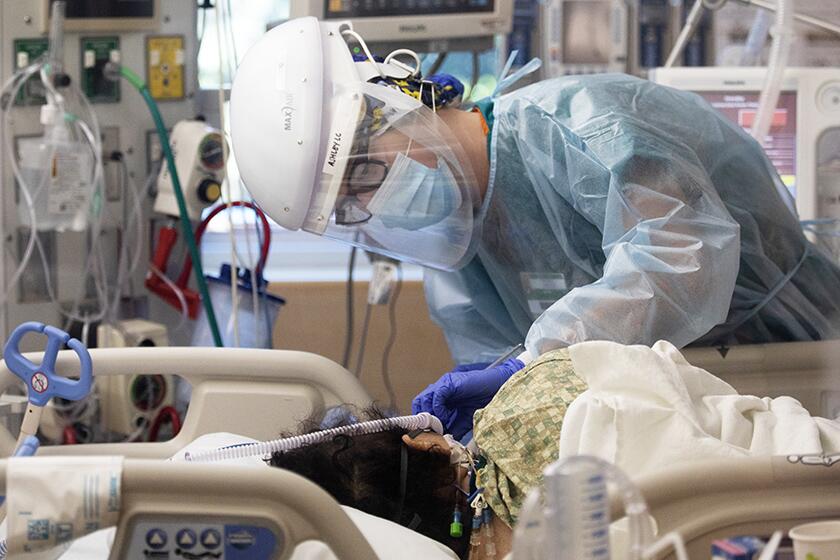‘We’re going to be New York’: L.A. hospitals brace for the worst

- Share via
There is a growing sense of dread in hospitals across Los Angeles County and the rest of California that the already grim conditions are about to get much worse and that the coming holidays could bring yet another surge of COVID-19 patients.
There were 16,843 COVID-19 patients in California hospitals Saturday, and 3,614 of them were in intensive care units, according to data released Sunday by the state — a huge increase from two months ago, when there were 2,291 patients and 657 in ICUs. On Saturday, Los Angeles County hospitals were treating the largest share of patients: 5,709, with 1,175 in ICUs.
Availability of ICU beds in Southern California and the San Joaquin Valley remained at zero Sunday.
ICU availability in Southern California at 0%, and the crisis is expected to get worse, officials warn.
A doctor at an L.A. County public hospital said the number of COVID-19 patients is “increasing exponentially, without an end in sight.”
Many parts of that hospital are being converted to COVID-19 wards, and ICU teams are being staffed up with workers from other departments that are temporarily halting services. The doctor, who was not authorized to speak to the media and requested anonymity, said it appears that by early January, the hospital will have to begin rationing care.
“We’re going to be New York, with bodies piling up. Wouldn’t be surprised if L.A. rings in the new year as the COVID capital of the world,” the physician said. “I don’t know how many ways to explain to people to isolate and stay home, short of bringing a camera to the ICU and [emergency department] to show them the mess of what we’re experiencing.”
Dr. Timothy Brewer, an epidemiologist at UCLA, agreed that L.A. County is on a dangerous path.
“I have yet to see any clear signals that things are slowing down, and I’m very concerned about the next two months,” he said.
He worries that any precautions being taken now will loosen in late December, as people gather for Christmas and New Year’s Eve, adding to the current surge.
Already, UCLA Health is scheduling multiple infectious-disease doctors to be on call at any time, due to the unprecedented numbers of COVID-19 patients needing hospitalization, he said. The biggest issue is that hospitals may quickly run out of providers who can administer ICU-level care and will be forced to draft doctors from other specialties.
“I haven’t done ICU medicine since I was a resident — you don’t want me adjusting your ventilator,” he said. “That’s the challenge, actually — it isn’t so much space, it’s staff. It’s the physicians, the nurses, the respiratory therapists, all of the trained people to do that highly specific work that you can’t just pull out of a hat.”
Patient volume is expected to increase, as new infections are occurring more quickly than at any other point during the pandemic and often take two to three weeks to result in hospitalization.
L.A. County public health officials announced Saturday that the county had surpassed 600,000 total coronavirus cases, an especially troubling development given that it arrived only eight days after the county reached 500,000.
By comparison, after L.A. County surpassed 200,000 reported cases Aug. 6, it took 80 days to reach 300,000. As the transmission rate began to climb, L.A. County reported its 400,000th case 36 days after that, on Nov. 30. Just 11 days later, the county topped 500,000.
On Sunday, the county recorded 12,763 new cases and 53 deaths, bringing its totals to 623,670 cases and 8,875 deaths, according to an independent tally by The Times. New case numbers are often lower on the weekends, when some laboratories don’t report results.
The share of tests coming back positive for the virus each day has also risen sharply, topping 16% over the last seven days, officials said Sunday. The positivity rate — which helps analysts determine whether more new cases are being identified due to increased transmission or because more people are being tested — reached 10% during the height of the last surge, in mid-July, then fell to around 3% in October.
Many hospitals are preparing for the possibility of rationing care in the coming weeks as the number of patients exceeds their staffs’ abilities to care for them. A document obtained by The Times, outlining how to allocate resources in a crisis situation, was recently circulated among doctors at the four hospitals run by Los Angeles County.
The guidelines call for a shift in mindset that is unfamiliar to many medical providers. Instead of trying everything to save a patient, the goal during a crisis is to save as many patients as possible, meaning those less likely to survive will not receive the level of care they would have otherwise. In other words, doctors will no longer be pulling out all the stops to save a life but, instead, will be strategizing about how to keep as many people as possible from perishing.
More to Read
Sign up for Essential California
The most important California stories and recommendations in your inbox every morning.
You may occasionally receive promotional content from the Los Angeles Times.













